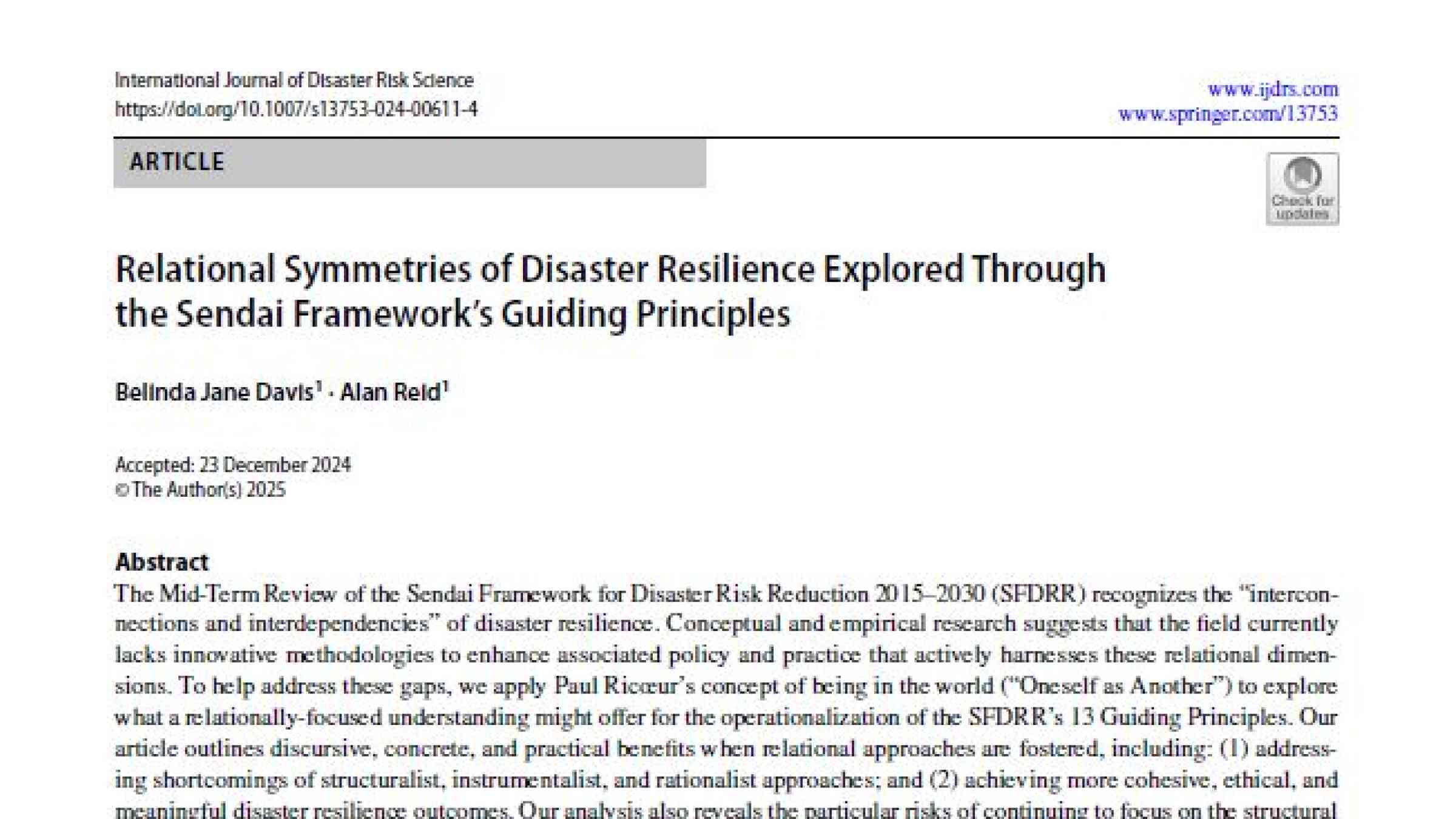Relational symmetries of disaster resilience explored through the Sendai Framework’s guiding principles – PreventionWeb

Exploring a Relational Approach for Disaster Risk Reduction

The following report applies Paul Ricœur’s concept of being in the world (“Oneself as Another”) to examine the potential benefits of a relationally-focused understanding in the implementation of the Sendai Framework for Disaster Risk Reduction (SFDRR) 13 Guiding Principles. By prioritizing relational approaches, this report aims to address the limitations of structuralist, instrumentalist, and rationalist approaches, and to achieve more cohesive, ethical, and meaningful disaster resilience outcomes.
Benefits of Relational Approaches
- Addressing shortcomings of structuralist, instrumentalist, and rationalist approaches
- Achieving more cohesive, ethical, and meaningful disaster resilience outcomes
By fostering relational approaches, this report highlights the potential discursive, concrete, and practical benefits. It emphasizes the importance of moving away from solely focusing on the structural organization of the SFDRR’s disaster resilience policy and practice, and instead, paying attention to relational dimensions and processes.
Risks of Neglecting Relational Dimensions
- Limiting ourselves to an instrumentally-driven, disconnected discourse and narrative of responses to disaster
- Favoring the Self gaining resilience “through” Another
This analysis reveals the risks associated with neglecting relational dimensions in disaster resilience efforts. By solely prioritizing instrumental approaches, there is a danger of perpetuating a disconnected discourse and narrative of disaster response. Additionally, focusing on the Self gaining resilience “through” Another can lead to asymmetrical forms of policy and practice.
The authors of this report advocate for a relational style of building resilience by emphasizing a robust sense of Oneself “with” Another. By prioritizing this sense of “with,” there is a potential to shift towards symmetrical forms of policy and practice for future disaster resilience.
SDGs, Targets, and Indicators
1. Which SDGs are addressed or connected to the issues highlighted in the article?
- SDG 1: No Poverty
- SDG 10: Reduced Inequalities
- SDG 11: Sustainable Cities and Communities
- SDG 13: Climate Action
- SDG 16: Peace, Justice, and Strong Institutions
The article discusses the operationalization of the Sendai Framework for Disaster Risk Reduction (SFDRR) and the need for a relational approach to achieve more cohesive and meaningful disaster resilience outcomes. This aligns with the goals of reducing poverty (SDG 1), reducing inequalities (SDG 10), creating sustainable cities and communities (SDG 11), taking action on climate change (SDG 13), and promoting peace, justice, and strong institutions (SDG 16).
2. What specific targets under those SDGs can be identified based on the article’s content?
- Target 1.5: By 2030, build the resilience of the poor and those in vulnerable situations and reduce their exposure and vulnerability to climate-related extreme events and other economic, social, and environmental shocks and disasters (SDG 1)
- Target 10.2: By 2030, empower and promote the social, economic, and political inclusion of all, irrespective of age, sex, disability, race, ethnicity, origin, religion, or economic or other status (SDG 10)
- Target 11.5: By 2030, significantly reduce the number of deaths and the number of people affected and substantially decrease the direct economic losses relative to global gross domestic product caused by disasters, including water-related disasters, with a focus on protecting the poor and people in vulnerable situations (SDG 11)
- Target 13.1: Strengthen resilience and adaptive capacity to climate-related hazards and natural disasters in all countries (SDG 13)
- Target 16.7: Ensure responsive, inclusive, participatory, and representative decision-making at all levels (SDG 16)
The article emphasizes the need to build resilience for the poor and vulnerable (Target 1.5), promote social inclusion (Target 10.2), reduce the impact of disasters on people and economies (Target 11.5), strengthen resilience to climate-related hazards (Target 13.1), and ensure inclusive decision-making processes (Target 16.7).
3. Are there any indicators mentioned or implied in the article that can be used to measure progress towards the identified targets?
No specific indicators are mentioned in the article. However, potential indicators to measure progress towards the identified targets could include:
- Number of people lifted out of poverty and vulnerability
- Level of social, economic, and political inclusion
- Number of deaths, affected people, and economic losses caused by disasters
- Investments in resilience-building and adaptation measures
- Level of inclusivity in decision-making processes
These indicators would provide insights into the progress made in achieving the targets related to poverty reduction, social inclusion, disaster impact reduction, climate resilience, and inclusive decision-making.
SDGs, Targets, and Indicators
| SDGs | Targets | Indicators |
|---|---|---|
| SDG 1: No Poverty | Target 1.5: By 2030, build the resilience of the poor and those in vulnerable situations and reduce their exposure and vulnerability to climate-related extreme events and other economic, social, and environmental shocks and disasters | Number of people lifted out of poverty and vulnerability |
| SDG 10: Reduced Inequalities | Target 10.2: By 2030, empower and promote the social, economic, and political inclusion of all, irrespective of age, sex, disability, race, ethnicity, origin, religion, or economic or other status | Level of social, economic, and political inclusion |
| SDG 11: Sustainable Cities and Communities | Target 11.5: By 2030, significantly reduce the number of deaths and the number of people affected and substantially decrease the direct economic losses relative to global gross domestic product caused by disasters, including water-related disasters, with a focus on protecting the poor and people in vulnerable situations | Number of deaths, affected people, and economic losses caused by disasters |
| SDG 13: Climate Action | Target 13.1: Strengthen resilience and adaptive capacity to climate-related hazards and natural disasters in all countries | Investments in resilience-building and adaptation measures |
| SDG 16: Peace, Justice, and Strong Institutions | Target 16.7: Ensure responsive, inclusive, participatory, and representative decision-making at all levels | Level of inclusivity in decision-making processes |
Source: preventionweb.net








